view online at https://www.tasart.co.nz/email/mailout.php?content_id=3
Hi , welcome to issue #3 of the Tasart newsletter. Our classes and workshops are now underway with a good turn-out. We will hopefully be sharing artist's work from our Saturday workshops soon. We will also be working on a Facebook page so that our customers can share what they are working on and ask questions and receive technical support, if needed.
Product Spotlight
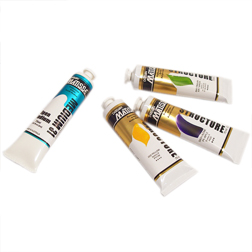
Matisse MM31 Open Medium
MM31 Open Medium is formulated to be mixed with Matisse Structure Acrylic colours to assist in prolonging drying time while maintaining the consistency of the paint. When mixed with Matisse Structure, they will retain their impasto quality. Optimal for painting outdoors or in particularly hot weather, MM31 Open Medium allows the paint to be blended on the painting surface for longer. Artists will be delighted with the way this medium makes their paint handle, so smooth and buttery. Be surprised by the glowing satin finish that this medium imparts to the paints.
Available now
Takapuna Art Supplies is offering, for a limited time: Buy 3 x 75ml tubes of Matisse Structure Acrylic and receive a 75ml tube of Matisse MM31 Open Medium, FREE. This special offer ends October 31, 2010.
Getting down to business
Legal rights of artists'
Thanks Graham from Waihi, for your comment and question below, regarding taking photos for reference.
"Thanks for the newsletter, I think it is a great idea. Which prompts to see if you can assist with the other question that people have concerning Copyright, Moral Rights when "taking photos". If a person is in a public place and takes photos of say, people on the beach, can that person paint pictures of those people and then sell the art work. Who if anyone has the Copyright, Moral Rights in such a case. I have tried to find the answer to this one on the net and have had no success. I hope you can help. Cheers, Graham"
* * *
Remembering that we as artists have freedom of expression, citizens also have the right to privacy and we must take certain considerations when creating artworks that incorporate figures. Although a common mistake, it is unlawful to paint the portrait of a person without written permission. It's good practice to retain a personal release from the "model". A release should have the date, the subject matter, the extent of the release, transfer of payment if any, who other than the artist may benefit from the release and the signature of the individual. Or, if the subject is a minor, the signature from the minor's guardian. If the artist is using photography other than their own, the photographer's copyright must be taken into consideration, remembering that the person who has taken the photo is also an artist and their work is also protected by copyright.
If you are taking "slice of life" photography and producing artworks, it's impractical to get model releases from every individual on a beach or dining at a cafe. It is much easier to make the people in the artwork ambiguous by changing features so that the subjects are unrecognizable. It's easier to "Frankenstein" the images; transforming features, changing clothing and/or hair color. The reference must be changed so that there would be no doubt from the viewer, that the figure was not a "portrait" of the person in question. The same applies if the artists is using another artist's photography. The image must be radically changed so that it is unrecognizable to the viewer, and that it is not a copy of another artist's photograph.
Did you know that certain celebrities don't own their own images? Many athletes, for example, "give" their image to their sponsors. Nike actually owns Tiger Woods' image, and an artist would have to get permission from Nike to paint a portrait of Woods. When Jim paints an illustration of an N.F.L. athlete, he only uses reference provided by The National Football League. Although he may download images from the internet, they are only used for cross-reference; to obtain more information on a uniform to complete information that may have not been provided in the reference, for example.
When is it okay to use copyrighted material or a person's image without their permission?
Fair Use is a term for artworks that are used for purposes such as criticism, comment, news reporting, teaching or research. In other words, when the artwork is used for non-profit. Artwork can also be copied for the purpose of Parody but only when there is no value added by adding material, i.e. collage, by copying or, there is no defamation of character. In each case, there must be consideration on how the use will effect the person, the market and value of the original work.
A good rule of thumb is always, If in doubt, Don't. After all, the purpose of copyright is to reward creativity and to advance the professional status of the visual communicator.
Product Review
Le Stig test-drives products & reviews
"A poor craftsman blames his tools."
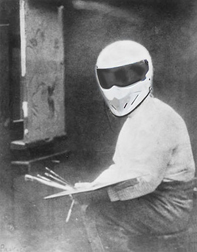
There is so much misinformation and half-truths out there, it can be pretty confusing for the artist. Since the majority of art supply stores in New Zealand own product agencies (which we do not), we've decided to commission a 'tester' who will test products and give unbiased opinions, and test products against one another. The first test our 'Technical Support Champion' performed was a test using a low-cost FAS poster paint. Here are the results:
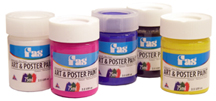
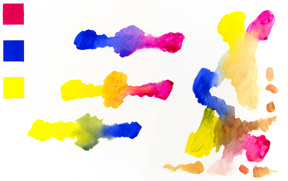
First, le Stig made puddles of primaries (yellow, magenta and "ultra" blue) and brought them together wet into wet creating secondaries. Though, impressed with the viscosity of the paint our TSC's only one negative comment: "Ultra bleu is too warm and makes an ugly secondary green when mixed with the yellow that looks like goose merde." "The bleu when mixed with the magenta is okay, but not vibrant." "However, the yellow mixed into the magenta created a very nice orange and the orange responded well with the somewhat inadequate bleu mixtures to create some adequate tertiaries."

Next, our TSC painted four head sketches that tested the versatility of the product. For the first sketch le Stig painted in the water colour style, light to dark in an overlapping fashion trying to use a damp or wet brush to blend colour. This was a revelation: "Unlike most poster paints the FAS paint dries quickly into the support and cannot be reactivated and carefully blended like other aquarelle, traditional poster or gouache paints." "This paint dries rapide de la acrylic and remains impermeable to overlapping coats."
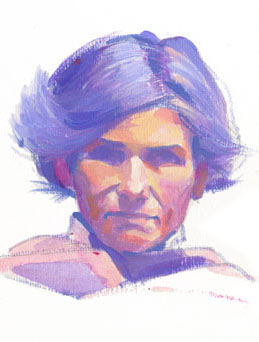
The second sketch was painted opaquely. Adding white to each colour mixture our TSC painted thickly in high key values. "The paint responded beautifully. It made creamy mixtures that were easy to blend. The paint remained moist just long enough for successful feathering of edges when needed."

The third sketch was also painted opaquely. Modeling the head in various values of warms and cools le Stig then completed the painting by adding a transparent warm yellow orange wash over the entire sketch. "The yellow orange wash brought the whole temperature of sketch together. Again, the paint did exactly what I asked it to do. The wash went down remarkablely well with no unpleasant streaking or staining."
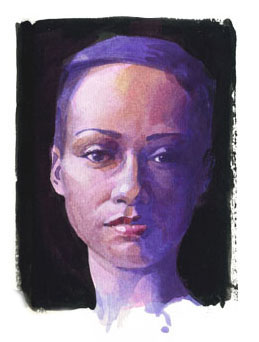
The final sketch was an experiment to see if white could be applied over transparently painted areas without creating a chalky film. Again le Stig was satisfied. "The white handled particularly well in both wet and dry applications. A very impressive paint for what it is."
FAS Art & Poster Paint
The Good:
- The paint texture is good and thick and when thinned with water the pigment remains reasonably intense and even. The paint is not troublesome to mix and the fast drying time is retarded just enough to enable blending for an experienced painter. The pigments are lightfast and when applied to the proper support will create a painting that is archival.
The Bad:
- The colour range is very limited and with the exception of the yellow the true primary colours are not in the range as we had to substitute the fluorescent magenta and settle for the ultramarine bleu. But, the paint is what it is an unpretentious, made in New Zealand, hobby and sign paint.
The Ugly:
- Ugly is a pejorative that we feel should be reserved for the pretentious. This product does not meet that criteria.

* * *
Until next time,
Sandy and Jim,
Takapuna Art Supplies
www.tasart.co.nz
Subscription
SUBSCRIBE:
You can subscribe to The Artist's Newsletter at www.tasart.co.nz/email/
UNSUBSCRIBE:
You can unsubscribe by changing your account preferences at www.tasart.co.nz/account/profile or by following this link:
http://www.tasart.co.nz/email/optout.php?rid=&vid=759&eid=
Comments
We'd love to hear from you! If you have any suggestions on how we can improve this newsletter please send comments to info@tasart.co.nz
* * *
This newsletter was written by Sandy Hartley Auckland on 2010-09-30
…
© Takapuna Art Supplies. All Rights Reserved. www.tasart.co.nz